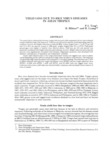Yield Loss Due to Rice Virus Diseases in Asian Tropics
Tropical agriculture research series : proceedings of a symposium on tropical agriculture researches
| ISSN | 03889386 |
|---|---|
| NII recode ID (NCID) | AA00870529 |

Full text
tars22-_93-100.pdf1.52 MB
The quantitative relationship between tungro infection and yield components of rice was evaluated using a modified single tiller approach. Yield loss per hill and per panicle varied depending upon the symptom severity and height reduction in infected IR64. Losses ranged from 1.1 to 99.1% per hill and 1.0 to 96.1 per panicle. Losses in 1000 grain- weight ranged from 13.5 to 57.8%. Field grain percentages were higher in healthy than infected plants. Yield loss per hill and panicle was positively correlated with height reducticn and symptom severity. Height reduction and symptom severity were significantly correlated with biomass. Regression equations were developed with different combinations of dependent and independent variables.
Grain yield reduction due to the tungro-associated viruses and ragged stunt virus in plants varied depending on the cultivars and growth stage when the plants were infected. The reduction was generally high when the plants were infected at 1-5 wk after soaking. The reduction was 17 -97% in plants infected with both rice tungro bacilliform virus (RTBV) and rice tungro spherical virus (RTSV), 12-90% with RTBV, 1-40% with RTSV, and 22-100% with rice ragged stunt virus. Cultivars with a lower yield reduction showed milder symptoms and contained a lower amount of virus in plants.
Grain yield reduction due to the tungro-associated viruses and ragged stunt virus in plants varied depending on the cultivars and growth stage when the plants were infected. The reduction was generally high when the plants were infected at 1-5 wk after soaking. The reduction was 17 -97% in plants infected with both rice tungro bacilliform virus (RTBV) and rice tungro spherical virus (RTSV), 12-90% with RTBV, 1-40% with RTSV, and 22-100% with rice ragged stunt virus. Cultivars with a lower yield reduction showed milder symptoms and contained a lower amount of virus in plants.
| Date of issued | |
|---|---|
| Creator | P. S. Teng H. Hibino H. Leung |
| Publisher | Japan International Research Center for Agricultural Sciences |
| Volume | 22 |
| spage | 93 |
| epage | 100 |
| Language | eng |
